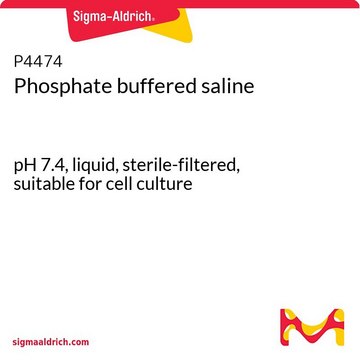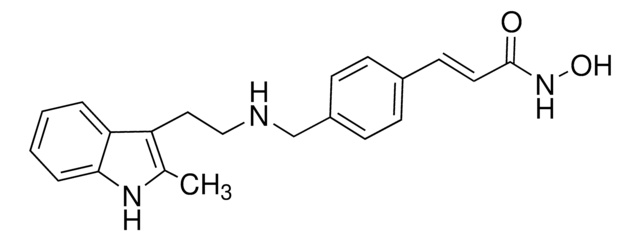SML1781
PDD00017273
≥98% (HPLC), powder, poly(ADP-ribose) glycohydrolase inhibitor
Synonym(s):
1-[(1,3-Dimethyl-1H-pyrazol-5-yl)methyl]-1,2,3,4-tetrahydro-N-(1-methylcyclopropyl)-3-[(2-methyl-5-thiazolyl)methyl]-2,4-dioxo-6-quinazolinesulfonamide
Sign Into View Organizational & Contract Pricing
All Photos(1)
About This Item
Empirical Formula (Hill Notation):
C23H26N6O4S2
CAS Number:
Molecular Weight:
514.62
MDL number:
UNSPSC Code:
12352200
NACRES:
NA.77
Recommended Products
product name
PDD00017273, ≥98% (HPLC)
Quality Level
Assay
≥98% (HPLC)
form
powder
color
white to beige
solubility
DMSO: 10 mg/mL, clear
storage temp.
2-8°C
Biochem/physiol Actions
PDD00017273 is a potent and selective inhibitor of Poly(ADP-ribose) glycohydrolase (PARG), which catalyses hydrolysis of the O-glycosidic linkages of ADP-ribose polymers, reversing the effects of poly(ADP-ribose) polymerases (PARPs). PARG has been shown to be involved in the repair of single strand DNA breaks. PDD00017273 is selective for PARG, with EC50 = 26 nM, compared to values of 30 μM for PARP1 and ARH3.
PDD00017273 is cell permeable in nature. It is used for specific killing of cells defective in certain homologous recombination (HR) proteins such as breast cancer gene 1/2 (BRCA1/2).
Storage Class Code
11 - Combustible Solids
WGK
WGK 3
Flash Point(F)
Not applicable
Flash Point(C)
Not applicable
Certificates of Analysis (COA)
Search for Certificates of Analysis (COA) by entering the products Lot/Batch Number. Lot and Batch Numbers can be found on a product’s label following the words ‘Lot’ or ‘Batch’.
Already Own This Product?
Find documentation for the products that you have recently purchased in the Document Library.
Dominic I James et al.
ACS chemical biology, 11(11), 3179-3190 (2016-10-01)
The enzyme poly(ADP-ribose) glycohydrolase (PARG) performs a critical role in the repair of DNA single strand breaks (SSBs). However, a detailed understanding of its mechanism of action has been hampered by a lack of credible, cell-active chemical probes. Herein, we
Radiosensitization with an inhibitor of poly (ADP-ribose) glycohydrolase: A comparison with the PARP1/2/3 inhibitor olaparib.
Gravells P, et al.
DNA Repair, 61, 25-36 (2018)
Polly Gravells et al.
DNA repair, 61, 25-36 (2017-11-28)
Upon DNA binding the poly(ADP-ribose) polymerase family of enzymes (PARPs) add multiple ADP-ribose subunits to themselves and other acceptor proteins. Inhibitors of PARPs have become an exciting and real prospect for monotherapy and as sensitizers to ionising radiation (IR). The
Evgeniia Prokhorova et al.
Molecular cell, 81(12), 2640-2655 (2021-05-22)
ARH3/ADPRHL2 and PARG are the primary enzymes reversing ADP-ribosylation in vertebrates, yet their functions in vivo remain unclear. ARH3 is the only hydrolase able to remove serine-linked mono(ADP-ribose) (MAR) but is much less efficient than PARG against poly(ADP-ribose) (PAR) chains in vitro.
Our team of scientists has experience in all areas of research including Life Science, Material Science, Chemical Synthesis, Chromatography, Analytical and many others.
Contact Technical Service







